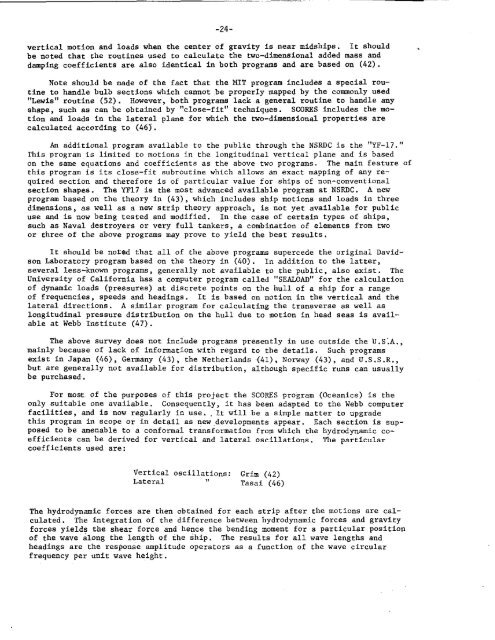load criteria for ship structural design - Ship Structure Committee
load criteria for ship structural design - Ship Structure Committee
load criteria for ship structural design - Ship Structure Committee
Create successful ePaper yourself
Turn your PDF publications into a flip-book with our unique Google optimized e-Paper software.
-24-<br />
vertical motion and <strong>load</strong>s when the center of gravity is near mid<strong>ship</strong>s. It should .<br />
be noted that the routines used to calculate the two-dimensional added mass and<br />
damping coefficients are also identical in both programs and are based on (42) .<br />
Note should be made of the fact that the MIT program includes a special routine<br />
to handle bulb sections which cannot ,be properIy mapped by the commonly used<br />
“Lewis” routine (52) . However, both programs lack a general routine to handle any<br />
shape, such as can be obtained by “close-fit” techniques. SCOfU3S includes the motion<br />
and <strong>load</strong>s in the lateral plane <strong>for</strong> which the two-dimensional properties are<br />
calculated according to (46].<br />
An additional program available to the public through the NSRDC is the “YF-17. “<br />
This program is limited to motions in the longitudinal vertical plane and is based<br />
on the same equations and coefficients as the above two programs. The main feature of<br />
this program is its close-fit subroutine which allows an exact mapping of any required<br />
section and there<strong>for</strong>e is of particular value <strong>for</strong> <strong>ship</strong>s of non-conventional<br />
section shapes . The YF17 is the most advanced available program at NSFOC. A new<br />
program based on the theory in (43) , which includes <strong>ship</strong> motions and <strong>load</strong>s in three<br />
dimensions, as well as a new strip theory approach, is not yet available <strong>for</strong> public<br />
use and is now being tested and modified. In the case of certain types of <strong>ship</strong>s,<br />
such as Naval destroyers or very full tankers, a combination of elements from two<br />
or three of the above programs may prove to yield the best resdts .<br />
It should be noted that all of the above programs supercede the original Davidson<br />
Laboratory program based on the theory in (40) . In addition to the latter,<br />
several less-known programs, generally not available to the public, also exist. The<br />
University of Cali<strong>for</strong>nia has a computer program called “SEALOAD” <strong>for</strong> the calculation<br />
of dynamic <strong>load</strong>s (pressures) at discrete points on the hull of a <strong>ship</strong> <strong>for</strong> a range<br />
of frequencies, speeds and headings. It is based cm motion in the vertical and the<br />
lateral directions. A similar program <strong>for</strong> calculating the transverse as well as<br />
longitudinal pressure distribution on the hull due to motion in head seas is available<br />
at Webb Institute (47) .<br />
The above survey does not include programs presently in use outside the U.S LA.,<br />
mainly because of lack of in<strong>for</strong>mation with regard to the details. Such programs<br />
exist in Japan (46) , Germany (43) , the Netherlands (41) , Norway (43) , and U.S.S.R. ,<br />
but are generally not available <strong>for</strong> distribution, although specific runs can usually<br />
be purchased.<br />
For most of the purposes of this project the SCORSS program (Oceanics) is the<br />
only suitable one available. Consequently, it has been adapted to the Webb computer<br />
facilities, and is now regularly in use. It will be a simple matter to upgrade<br />
this program in scope or in detail as new ,developments appear. Each section is supposed<br />
to be amenable to a con <strong>for</strong>mal trans<strong>for</strong>mation from which the hydrodynamic coefficients<br />
can be derived <strong>for</strong> vertical and lateral oscillations. The particular<br />
coefficients used are:<br />
Vertical oscillations: Grim (42)<br />
Lateral ,,<br />
Tasai (46)<br />
The hydrodynamic <strong>for</strong>ces are then obtained <strong>for</strong> each strip after the motions are calculated.<br />
The integration of the difference between hydrodynamic <strong>for</strong>ces and gravity<br />
<strong>for</strong>ces yields the shear <strong>for</strong>ce and hence the bending moment <strong>for</strong> a particular position<br />
of the wave along the length of the <strong>ship</strong>. The results <strong>for</strong> all wave lengths and<br />
headings are the response amplitude operators as a function of the wave circular<br />
frequency per unit wave height .

















